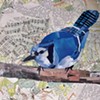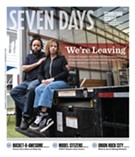Published July 1, 2012 at 4:00 a.m.
Teen fiction has changed since we were young. Before Harry Potter came along, few adults who weren't school librarians could name a single young-adult best seller. Many of us picked up Stephen King or Jane Austen when we hit adolescence, realized we could handle "grown-up" books just fine and never looked back.
Today, the average adult can rattle off not just the names of YA megahits, but the names of their protagonists and their dueling love interests. Blame Hollywood all you want for the Team Edward versus Team Jacob business. But Harry Potter, Twilight and The Hunger Games have plenty of grown-up readers, too.
There's a lot more to YA lit than those familiar titles, though, and some parents find it daunting or disturbing. Venture into that section of the bookstore, and you'll find yourself drowning in a sea of dark, glossy covers plastered with images of teen models who look like they just escaped from a pre-Raphaelite painting. Last year, in an influential piece in the Wall Street Journal, Meghan Cox Gurdon attacked the "Darkness Too Visible" of teen fiction, quoting a mother of three who lamented that she saw on the YA shelves "nothing, not a thing, that I could imagine giving my daughter. It was all vampires and suicide and self-mutilation, this dark, dark stuff."
Is YA really that bad? Gurdon's hand-wringing about "expletives" aside, readers of YA can confirm that there is a lot of "darkness" and, yes, violence there. In the best books, though, that darkness becomes an occasion for authors to examine disturbing aspects of our culture. Teen novels about futuristic polygamy, totalitarian personality testing and compulsory plastic surgery (actual examples!) play on young people's real-life anxieties and could start interesting conversations between teens and parents.
For the perplexed, here's a primer on popular YA subgenres, with examples we think stand above the crowd. (Note: By "young adult," we mean books targeted at ages 12 to 18, or sometimes 14 to 18. Books for the 8-to-12-year-old set are called "middle grade" by the publishing industry; see sidebar.)
For candid reviews by readers of all ages, your best source is goodreads.com, which will lead you to a multitude of YA bloggers. Find reviewers you trust and stick with them.
Dystopias and Future Shock
Thanks to the Hunger Games trilogy, the hottest trend in YA right now could be described as "1984 with cute boys." Writers are falling all over themselves to create totalitarian future societies that give teen protagonists a chance to be rebels with a cause.
Take last year's best-selling Divergent, by Veronica Roth, in which teenagers in a post-collapse Chicago must align themselves with social factions based on dominant personality traits and goals. Sure, it sounds silly, but any teen who has felt pigeonholed will relate to the heroine, who rejects her family's monkish "Abnegation" lifestyle for the tattoos and daredevil stunts of "Dauntless." Action packed (and, yes, violent), Divergent raises questions about the limits of selflessness and the nature of courage. A sequel is already out.
Also thoughtful is Scott Westerfeld's Uglies series, in which society has devised a high-tech solution to the problem of looks-based discrimination: Make everybody gorgeous. Will the heroine solve her problems by transforming from a gawky preteen into a vapid "Pretty"?
Harebrained social schemes are fun to imagine. But what about a future that could actually happen? Paolo Bacigalupi, also an adult science-fiction writer, explores an America fractured by climate change and resource depletion in the award-winning Ship Breaker, about a boy who risks his life to salvage copper from useless oil tankers.
Science Fiction
Dystopias may rule the YA best-seller lists, but traditional science fiction is gaining ground. Witness the recent success of Beth Revis' Across the Universe, in which a teen follows her parents into cryogenic freeze for a 300-year spaceship journey. When she's rudely awakened ahead of schedule, she must adjust to a culture of crew members who have spent generations in space. Revis uses her claustrophobic setting to raise knotty questions about the uses and abuses of power.
Set on a colonized planet, Patrick Ness' Chaos Walking trilogy broaches the same hot-button war and imperialism themes as the Hunger Games trilogy — in more artful prose. The first book, The Knife of Never Letting Go, introduces us to a boy who lives in a town where all the women have died and the men can't stop eavesdropping on each other's thoughts. From this nightmarish scenario, which Ness says was inspired by the internet, the trilogy evolves into a gripping coming-of-age saga with equally strong male and female protagonists.
Paranormal and Horror
Ever since the Twilight saga, tales of teenagers falling in love with supernatural critters have been huge. It's not just vampires, either: Werewolves, ghosts, fallen angels and even mermen are getting in on the tormented-romance action. Many of these books follow the gothic template that Jane Austen mocked centuries ago in Northanger Abbey: Girl meets brooding stranger; girl swoons, etc. And some of these novels' brooding strangers seem less like good boyfriends than, well, superpowered stalkers. (Twilight and Becca Fitzpatrick's popular Hush, Hush series often come in for this criticism.)
A refreshing change of pace is Kendare Blake's Anna Dressed in Blood, in which a ghost hunter finds himself falling for the specter he's supposed to exorcise. It's more "Buffy the Vampire Slayer" than Twilight, and be warned: There's gore. I've also heard great things about Maggie Stiefvater's Wolves of Mercy Falls series.
Urban Fantasy
In urban fantasy, magic is part of daily life, and fairies, demigods, demons and the like mingle with humans. So these books are like paranormal novels with less heavy breathing and more spell casting (not to be confused with YA steampunk, which has more robots and Victorian bustles).
Melissa Marr's Wicked Lovely series and Cassandra Clare's Mortal Instruments series both have legions of fans. My personal favorite, though, is the late English fantasy author Diana Wynne Jones, who was writing about shadow societies of magic users long before J.K. Rowling came along. Try her Fire and Hemlock, The Time of the Ghost and Archer's Goon.
Contemporary
When people complain about sex, swearing and sensationalism in YA lit, they're often talking about these books, set in present day and with no vampires or fairies in sight. But contemporary YA covers a vast range, from frothy, lighthearted chick-lit-type books to "problem" novels about cutting, date rape and suicide. Some are "literary" enough to cross the age divide.
Take The Fault in Our Stars, from cult author John Green, a recent best seller about a teen with a terminal cancer diagnosis who falls in love with a teen in remission. It's possibly the funniest, fiercest, least sentimental book about mortality I've read, featuring a few F-bombs and sex that occurs offscreen. The real question is, though, can your teen weather hours of sobbing?
What about middle-grade fiction?
"Middle-grade" lit, aimed at kids in third through seventh grades, has distinct differences from YA, and we don't just mean a PG rating. Because teen girls read more than teen boys — for whatever reason — female protagonists dominate YA, and romantic main plots or subplots are virtually inescapable. In MG, the genders get closer to equal representation. Action adventure and goofy gross-out humor are heavily represented here.
MG covers a vast territory, as we can see just from looking at some Vermont authors who write it. J&P Voelkel of Norwich (The Jaguar Stones trilogy) offer Indiana Jones-style adventure laced with silly jokes. Kate Messner of Plattsburgh (yes, Tom Messner's wife) tends to produce female-oriented contemporaries. But her new book, Capture the Flag (see "Kids Beat" pages 8-9), is an action-oriented mystery in which three seventh graders solve the theft of a national treasure. Phoebe Stone of Middlebury applies literary prose to bittersweet middle-school romance in her latest, The Boy on Cinnamon Street. Dayna Lorentz of Burlington makes canines the heroes of rousing adventures set against the backdrop of a national tragedy in her Dogs of the Drowned City series. Bonnie Shimko of Plattsburgh (who also writes YA) introduces kids to the civil rights era in her spirited historical novel The Private Thoughts of Amelia E. Rye.
Chris Tebbetts of Hinesburg rocketed to the top of the best-seller lists with Middle School, the Worst Years of My Life, a comic contemporary about a boy who breaks every rule in his school's code of conduct, coauthored with literary whirlwind James Patterson. The sequel — Middle School: Get Me Out of Here! — was just released. On his website (christebbetts.com), Tebbetts offers a handy list of his favorite books for young readers, past and present. Among the more recent MG titles he likes are The Game of Sunken Places, by M.T. Anderson (also an excellent YA writer); When You Reach Me, an acclaimed Sci-Fi-tinged mystery by Rebecca Stead; and R.J. Palacio's Wonder, about a boy born with a facial deformity.
For more recommendations, check out Goodreads, ask a librarian or consult the folks at Shelburne's Flying Pig Bookstore, who periodically host readings by popular MG authors.
This article was originally published in Seven Days' monthly parenting magazine, Kids VT.
More By This Author
Speaking of...
-

Vermont Book Award Winners Announced
May 6, 2023 -

Vermont State Colleges Reverse Library Layoffs, Athletics Shakeup
Apr 24, 2023 -

Local Children's Book Buyers Offer Reading Recommendations
Nov 15, 2022 -

The Inaugural Green Mountain Book Festival Kicks Off This Weekend
Sep 21, 2022 -

Fletcher Free Library Branch Coming to Burlington's New North End
Nov 19, 2021 - More »
Comments
Comments are closed.
From 2014-2020, Seven Days allowed readers to comment on all stories posted on our website. While we've appreciated the suggestions and insights, right now Seven Days is prioritizing our core mission — producing high-quality, responsible local journalism — over moderating online debates between readers.
To criticize, correct or praise our reporting, please send us a letter to the editor or send us a tip. We’ll check it out and report the results.
Online comments may return when we have better tech tools for managing them. Thanks for reading.














































